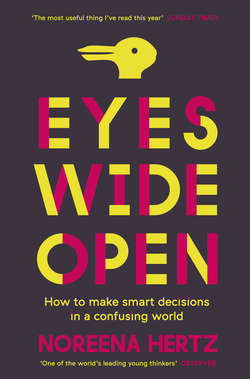Читать книгу Eyes Wide Open: How to Make Smart Decisions in a Confusing World - Noreena Hertz - Страница 16
All That Glitters …
ОглавлениеIn a complex world of hidden dangers and fleeting opportunities we all need to be able to see snakes as well as tigers.
We have to understand that the picture we see at first may not give us all the information we need to make the best possible decision. We need to learn to see beyond what is obvious, beyond what we are culturally or conventionally attuned to focus on.
Of course, this doesn’t mean that we shouldn’t ever act until we’ve gathered every single piece of information out there that may be relevant to our decision. That would be excessively time-consuming, and our brains wouldn’t be able to cope with all that data anyway.2
But what the tiger-and-the-snake experiment tells us is that the information we’re most prone to focus on may only give us a very partial story, a fragment of the truth, and therefore risks misleading us. Being aware of this, and adjusting accordingly, will make a profound difference to the decisions you make.
Take internet dating. Studies show that men are most attracted to photos of women with large eyes, a big smile and high cheekbones.3 Glossy hair, full lips and smooth skin are also a big draw.4 It’s also the case that women who describe themselves as ‘voluptuous’ or ‘portly’, or ‘large but shapely’, are contacted far less online than women who are slightly underweight.5
That’s how it goes with a lot of male browsers. What about women? Well, women seem to focus more on height. Men listed as between six foot three and six foot four receive about 60 per cent more first-contact emails than men in the five foot seven to five foot eight category.
But are superficial features such as the fullness of a woman’s lips or a man’s height really the best things to focus on if you’re looking to choose the right partner?
The answer, unsurprisingly, is a categorical ‘no’. Studies of successful long-term relationships point to less superficial qualities such as sense of humour, shared interests and common values as being much better indicators of whether a couple are well matched.6 Deep down, most of us know this, yet the majority of online daters only focus on one part of the picture.
Politicians, economists and investors can easily fall in to the same trap.
They tend to focus overwhelmingly on economic growth as the ultimate indicator of how well a country is doing. Yet growth indicators tell us nothing about how that growth was achieved.
If you cut all your trees down to sell the wood for kindling, that would be good for growth; but would it really be a measure of how successful you were as a nation? Clearly not. Think of all the problems that the destruction of the rainforests has caused to local habitats as well as its contribution to global warming. Then add to that the very significant associated future economic costs of this kind of short-term thinking.
‘Growth’ also does not tell us anything about how spoils are shared, about inequality levels, or gender differences, or the rumblings of discontent that can mutate into revolution. It yields, in reality, relatively little information on how a country is actually faring, or will fare in the future. In Russia, the economy has been growing at the same time as life expectancy has been falling.7 In the United States, during the noughties there was growth, but at the same time median family income declined, and there was no net job creation.8 So if you are a prime minister or an investor, or just a concerned citizen, the modern economic obsession with digits of growth can end up being the tiger that means you don’t see the snake creeping up on you on the forest floor.
Think also of the doctor who no longer carries out a physical examination or takes a detailed case history, but instead focuses overwhelmingly on blood tests or scan results – you’ve probably come across the type.
While blood tests and scans can of course yield important, often life-saving information, in many cases these static findings cannot on their own determine what is wrong with you. The best doctors are still those who listen to you, touch you and try to establish the individual characteristics of your situation. Such doctors use the static readings of your test results as potential clues to what’s wrong, but not as the sole way of defining and diagnosing you.9 As Dr Athina Tatisoni, of the prestigious Tufts University School of Medicine, remarks:
Usually what happens is that the doctor will ask for a suite of biochemical tests – liver fat, pancreas function, and so on … The tests could turn up something, but they’re probably irrelevant. Just having a good talk with the patient and getting a close history is much more likely to tell me what’s wrong.10
Doctors, like investors, like dating-site users, like all of us, need to get better at thinking about the whole picture. We need to look beyond what is immediately obvious or easy to see. For if we are to see a snake as well as a tiger, if we are to see what it is we need to see, we must remember that the information that glitters most brightly may not actually be what will serve us best.
